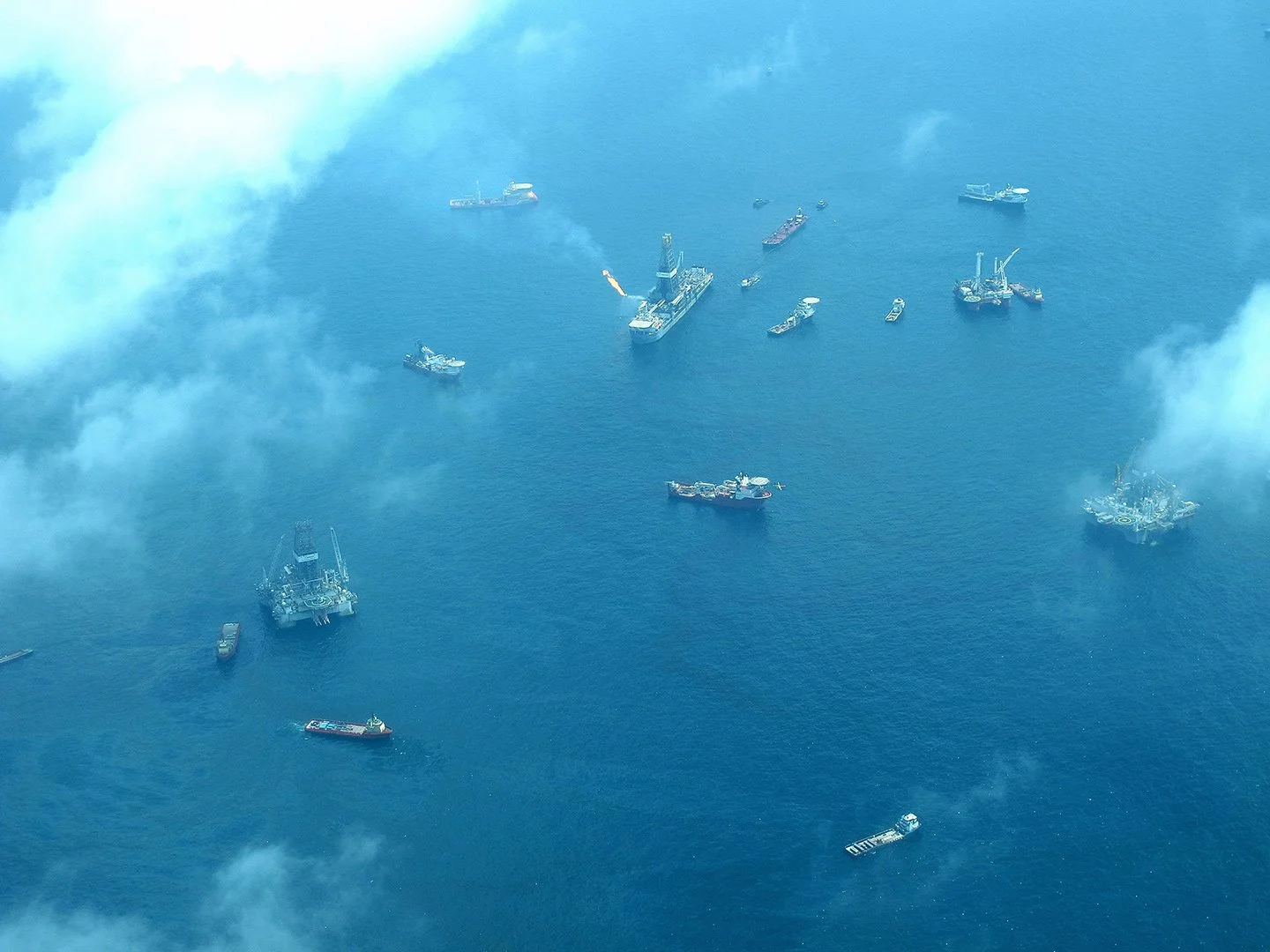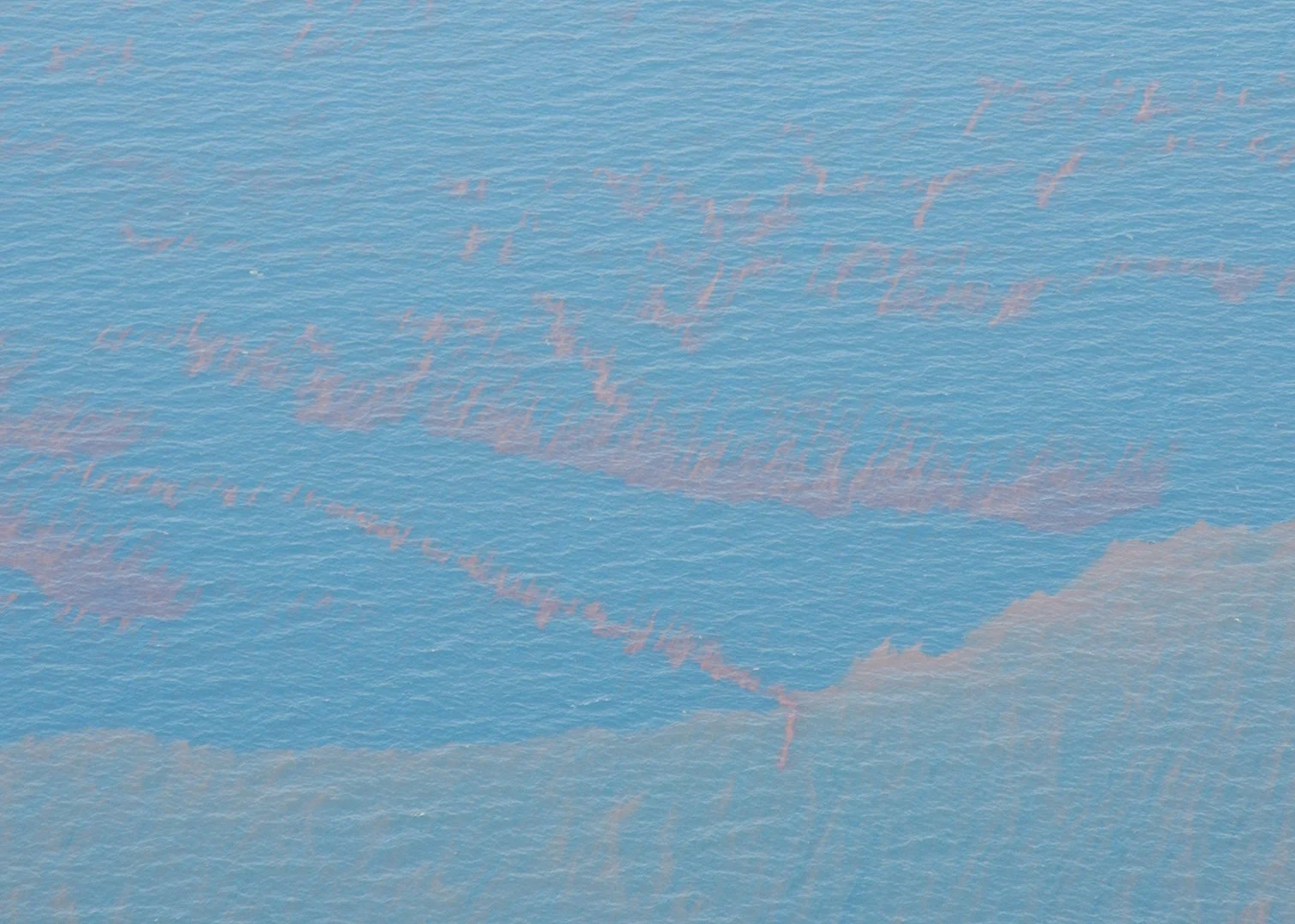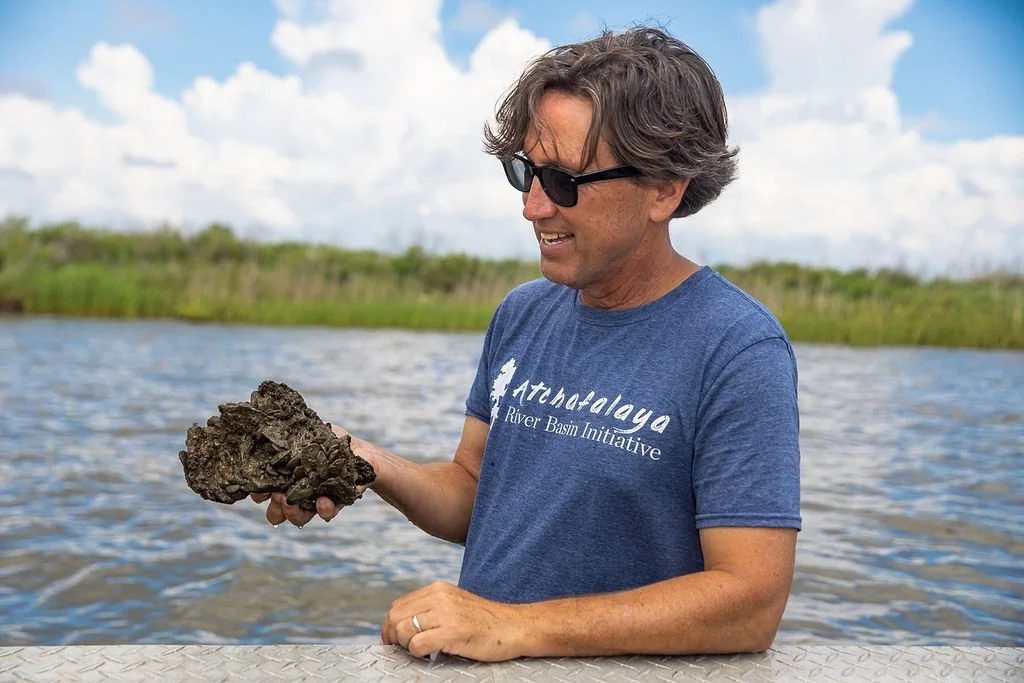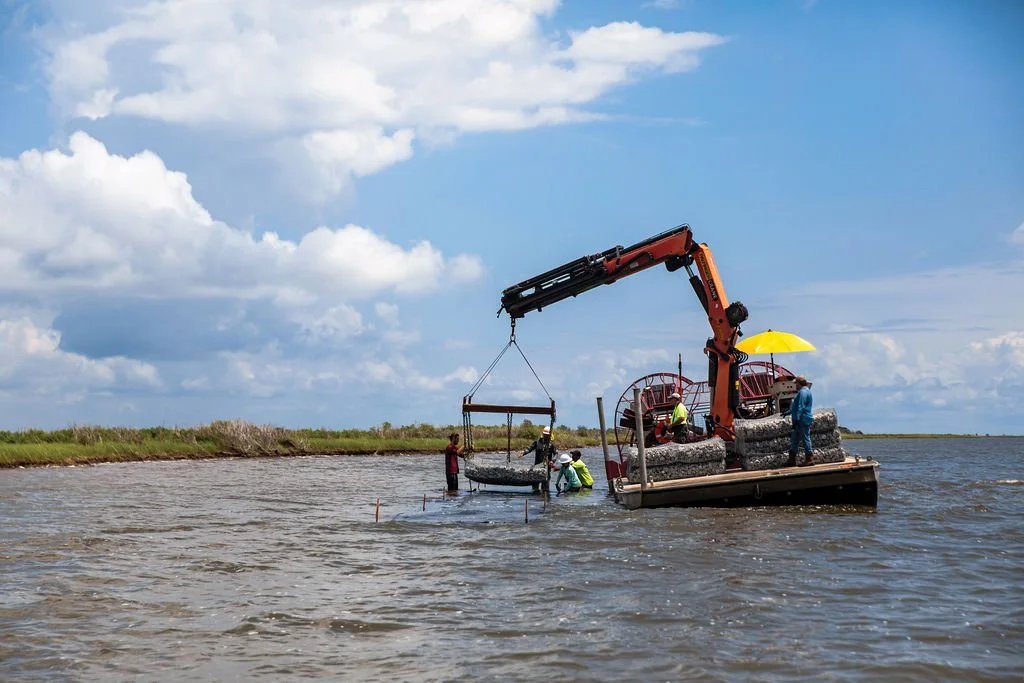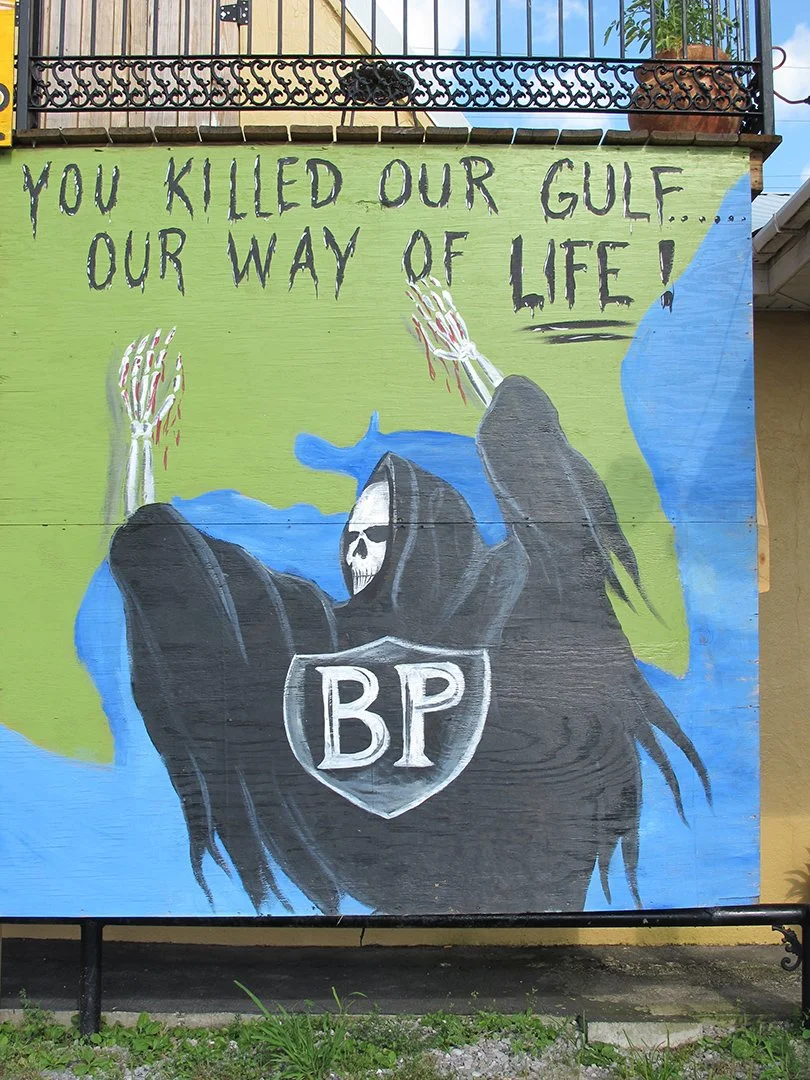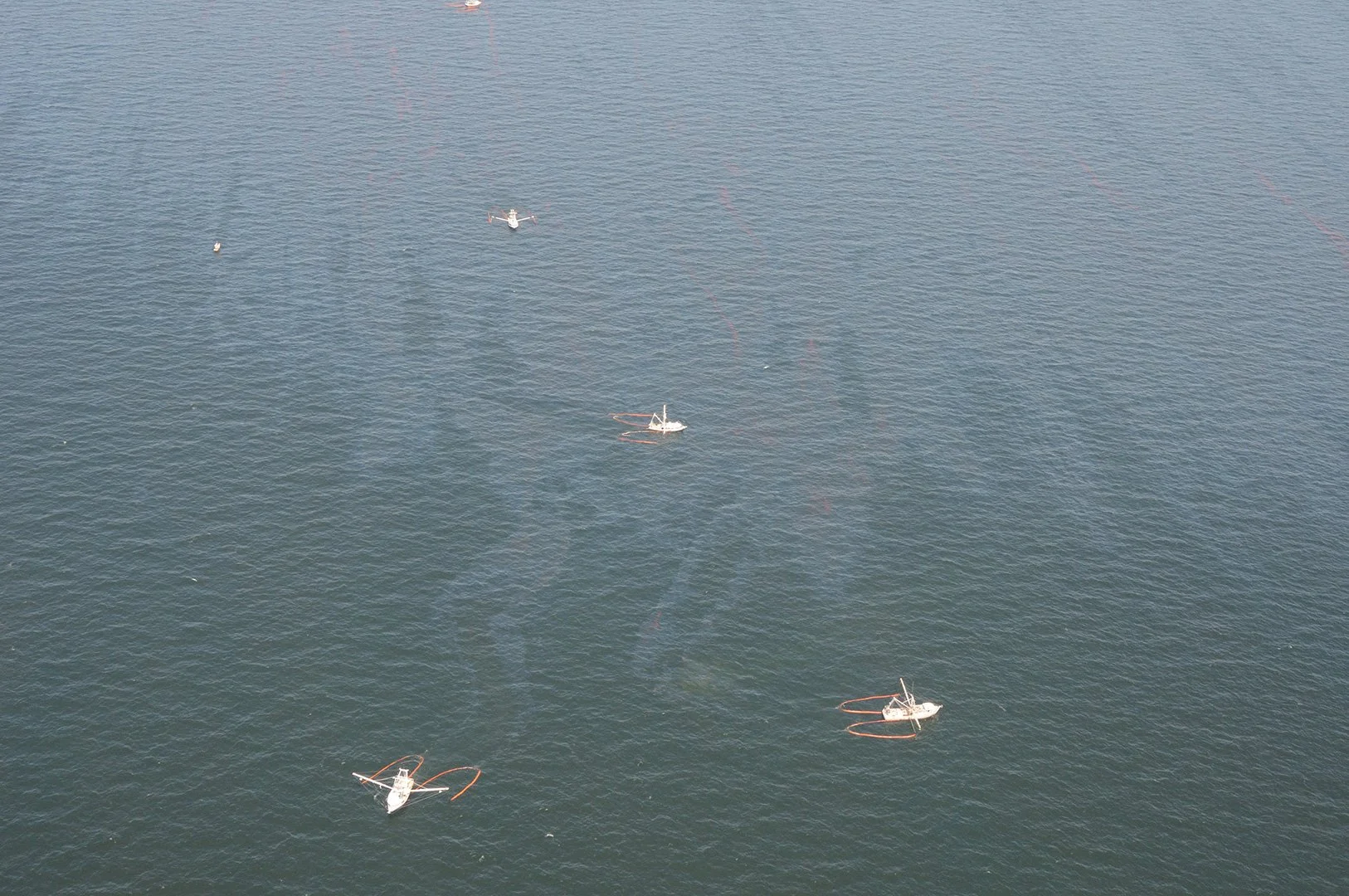It’s been 15 years since BP’s environmental disaster. Here’s where the Gulf stands today
By Safina Center Environmental Journalism Fellow Marlowe Starling
The site of the Deepwater Horizon oil spill in 2010. ©Carl Safina
The explosion happened two days before Earth Day.
When BP’s Deepwater Horizon oil rig blew, sinking two days later, so began an 87-day environmental disaster—one of the worst in the history of the U.S. A staggering 134 million gallons of black oil spewed into the Gulf of Mexico, and it was only a matter of time before scientists braced for the slick substance to hit the shores of Florida, Alabama, Louisiana, Mississippi, and Texas.
“Within a few days, it looked like this was not going to be something that was going to be plugged up and stopped,” said Carl Safina, who went to Louisiana after the blowout and authored the book A Sea in Flames: The Deepwater Horizon Oil Blowout.
Oil in the Gulf of Mexico after BP’s Deepwater Horizon oil rig exploded. ©Carl Safina
That was 15 years ago. The Gulf is now free of oil, but it’s still more imperiled than ever. Today, another human-caused disaster is compounding the environmental challenges in the Gulf of Mexico: Climate change continues to rear its head in its ever-warming water as toxic blooms cause neurological problems in its most endangered fish species, and as Gulf-spawned hurricanes threaten parts of the U.S. as far inland as Ashville, North Carolina.
Extreme conditions are putting stress on the entire ecosystem. Cold-stunned sea turtles struggle to cope with unexpected cold snaps. Hurricanes are becoming more intense and frequent, wrecking habitats for both people and animals. And extreme rainfall and prolonged drought are at two opposite ends of a hydrology conundrum.
Yet despite these critical threats, the Gulf of Mexico receives a lot less attention for ongoing climate change than what it received when the Deepwater Horizon rig exploded.
“There have been so many wake-up calls and we just keep hitting the snooze button on everything,” Safina said.
During its 15th anniversary, I wanted to know more about how the disaster affected Gulf Coast communities and what lessons we learned. What I found was surprising.
A lawn cemetery in Grand Isle, Louisiana, shortly after the Deepwater Horizon Blowout. ©Carl Safina
Exposing data gaps
As the Gulf Coast scrambled to assess the damage, scientists came to a startling realization: They had a dearth of data about the Gulf’s wildlife and environmental health.
In a weird way, the oil spill was a catalyst for better monitoring of Gulf ecosystems, explained Seth Blitch, the coastal and marine conservation director in Louisiana for The Nature Conservancy.
For a while, the scientific and conservation community was stunned by a sort of “uncomfortable awe” at how much oil was spewing into the Gulf each hour, Blitch recalls. Then, he and his colleagues “snapped out of it,” he says, and realized they had to collect as much information about the ecosystem as they could to establish a baseline — a measure of the existing environmental health, or the current “norm,” that they could compare against the potential effects of oil pollution.
The Nature Conservancy Louisiana Director of Conservation Seth Blitch inspects the oyster reefs in Calcasieu Lake. ©The Nature Conservancy
At the time, Blitch was working at the Florida Department of Environmental Protection as an administrator for the northwest region of the state—the part most likely to be hit with oil. By the second day of the spill, it became clear to them that there wasn’t going to be an easy way to tap the spill. So, their first order of business was to take water quality and sediment samples as measurements of general environmental health, not just in Florida, but across the five affected Gulf Coast states.
“We learned how much we didn’t know,” Blitch said.
Indeed, the most comprehensive book documenting the birds of the Gulf of Mexico was published in 2018—eight years after the BP oil spill, and only seven years ago. It was called “Birdlife of the Gulf of Mexico” by Joanna Burger, Safina’s doctoral advisor at Rutgers.
“Nobody had surveyed all the bird colonies to see how many birds there had been the year before. There were not good estimates of fish populations,” Safina said. “It was very hard to assess the damage because (scientists) had no baselines.”
In part, this black hole of data helped remind ecologists why long-term monitoring—collecting the same data over years and years—is so important, Safina purports. “How do you know how anything is changing if you don't know what it was like?”
Doing so helped to shine a light on problems that existed in the Gulf even before the spill, Blitch said, such as more frequent harmful algal blooms, issues with freshwater sedimentation in estuaries, and seagrass loss. To that end, The Nature Conservancy has implemented programs such as oyster reef restoration in Louisiana, protecting Gulf islands off the coast of Alabama, and nature-based solutions all along the coastline.
The Nature Conservancy installs oyster reefs in Calcasieu Lake in Louisiana. The Nature Conservancy’s Oyster Reef Restoration and Shoreline Protection project in West Cove of Calcasieu Lake is protecting more than four miles of shoreline along Sabine National Wildlife Refuge. ©The Nature Conservancy
The BP disaster also spurred cross-collaboration between state environmental agencies and other scientific groups, Blitch adds.
“People really rallied around doing what they can to have the data in hand in case there was damage,” he said.
Indeed, those early efforts led to long-term projects to monitor water quality across the Gulf. But while the human-caused disaster wreaked havoc on the ecosystem, exposing gaps in scientists’ data books and creating a push for more common-sense restoration tactics, the response wasn’t as long-lasting as some had hoped.
An oily mirror to anthropogenic climate change
The BP disaster issued an intense sense of urgency—one that people said would change the way we steward the Gulf. Some also hoped it would change the way we look at our greatest human-caused environmental disaster—climate change—differently. “And that all lasted five minutes,” Safina said.
Street art found near Grand Isle, Louisiana, in 2010. ©Carl Safina
The BP rig explosion wasn’t induced by climate change, but like modern-day climate change, it was a human-caused disaster. In the years since Safina visited Louisiana to see the damage firsthand to research his book—and since testifying at Congressional hearings about the terrible and widespread damage the blowout caused—he’s noticed a particularly interesting irony.
“Nobody denied that the blowout was there and that the blowout was bad,” he said. Yet “the kinds of people who tend to be deniers nowadays were the worst hit by that.”
Back when Blitch worked on aquatic preserves for the Florida environmental agency, he used to ask people at public meetings if there was anyone who wanted to see those areas degraded—a genuine question meant to probe curiosity. Nobody ever said yes. It highlighted an important point: Whether for aesthetic, economic, scientific, personal, or cultural reasons, these ecosystems hold great value to us all.
To be fair, Blitch adds, it’s difficult to maintain such a high level of vigilance about environmental health and conservation beyond the context of an acute environmental disaster. But the spill “put the Gulf in the minds of more people as a place that was worth protecting, conserving and fighting for,” he said.
What Blitch likes to emphasize is that our connections with the outdoors are about more than just enjoying so-called “nature.” They’re places that hold special memories. For him and millions of others, that place is the Gulf Coast.
As a kid, Blitch grew up fishing for redfish and trout with his dad and brothers in the Chassahowitzka swamp on the west coast of Florida, just south of Homosassa Springs. As he grew older, it became a place he took his wife, his dog, and his kids. “It was pretty foundational for me in a lot of ways,” he said.
But it’s also worthwhile to recognize the practical ways in which a healthy Gulf better serves us: robust fisheries, clean water, thriving local economies, shoreline protection, and public health, to name a few.
“We’re part of, not apart from, the natural world,” Blitches likes to say. “Taking care of systems like the Gulf of Mexico is an act of self-care.”
Cleaning up oil after the Deepwater Horizon blowout. ©Carl Safina

